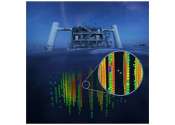The muon (pronounced /ˈmjuːɒn/; from the Greek letter mu (μ) used to represent it) is an elementary particle similar to the electron, with a unitary negative electric charge and a spin of ½. Together with the electron, the tau, and the three neutrinos, it is classified as a lepton. As is the case with other leptons, the muon is not believed to have any sub-structure at all (i.e., is not thought to be composed of any simpler particles).
The muon is an unstable subatomic particle with a mean lifetime of 2.2 µs. This comparatively long decay life time (the second longest known) is due to being mediated by the weak interaction. The only longer lifetime for an unstable subatomic particle is that for the free neutron, a baryon particle composed of quarks, which also decays via the weak force. All muons decay to three particles (an electron plus two neutrinos of different types), but the daughter particles are believed to originate newly in the decay.
Like all elementary particles, the muon has a corresponding antiparticle of opposite charge but equal mass and spin: the antimuon (also called a positive muon). Muons are denoted by μ− and antimuons by μ+. Muons were previously called mu mesons, but are not classified as mesons by modern particle physicists (see History).
Muons have a mass of 105.7 MeV/c2, which is about 200 times the mass of an electron. Since the muon's interactions are very similar to those of the electron, a muon can be thought of as a much heavier version of the electron. Due to their greater mass, muons are not as sharply accelerated when they encounter electromagnetic fields, and do not emit as much bremsstrahlung radiation. This allows muons of a given energy to penetrate far more deeply into matter than electrons, since the deceleration of electrons and muons is primarily due to energy loss by the bremsstrahlung mechanism. As an example, so-called "secondary muons", generated by cosmic rays hitting the atmosphere, can penetrate to the Earth's surface, and even into deep mines.
Because muons have a very large mass and energy compared with the decay energy of radioactivity, they are never produced by radioactive decay. They are, however, produced in copious amounts in high-energy interactions in normal matter, such as occur during certain particle accelerator experiments with hadrons, and also naturally in cosmic ray interactions with matter. These interactions usually first produce pi mesons, which then most often decay to muons.
As with the case of the other charged leptons, the muon has an associated muon neutrino. Muon neutrinos are denoted by ν
μ.









